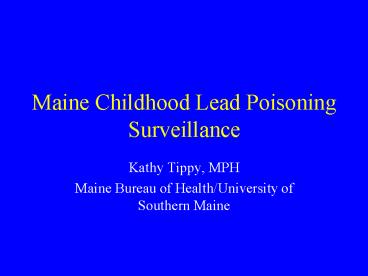Maine Childhood Lead Poisoning Surveillance - PowerPoint PPT Presentation
1 / 20
Title:
Maine Childhood Lead Poisoning Surveillance
Description:
Maine Childhood Lead Poisoning Surveillance. Kathy Tippy, MPH ... All blood lead samples (children 6 yrs) must be analyzed at the Health and ... – PowerPoint PPT presentation
Number of Views:71
Avg rating:3.0/5.0
Title: Maine Childhood Lead Poisoning Surveillance
1
Maine Childhood Lead Poisoning Surveillance
- Kathy Tippy, MPH
- Maine Bureau of Health/University of Southern
Maine
2
Childhood Lead Poisoning Surveillance
- Historical perspective
- National surveillance
- Maine surveillance
3
Historical Perspective
- Second century, B.C., Dioscorides
(1st.Neuro-toxicologist) - Lead makes the mind
give way. - Benjamin Franklin - symptoms of typesetters and
painters. - Nineteenth century, A.J. Turner and J.
Lockhart Gibson - disease one of habitation.
Needleman, H., National Health/Education
Consortium, 1992
4
National Surveillance
5
Evolution of blood lead levels
6
Progression of acceptable blood lead levels
7
Public Health Surveillance
- The ongoing systematic collection, analysis, and
interpretation of health data essential to the
planning, implementation and valuation of public
health practice, closely integrated with the
timely dissemination of these data to those who
need to know. The final link in the surveillance
chain is the application of these data to
prevention and control. - CDC 1986
8
Planning a surveillance system
- Considerations
- What do we want to know?
- What are our data sources?
- How will the data be analyzed?
- How will the information be disseminated?
- Who will use the information reported?
9
Maine Childhood Lead Poisoning Surveillance
- How many children 0-5 years of age living in
Maine are tested for lead poisoning? - Measurement Lead screening rates
- How many children 0-5 years of age living in
Maine have lead poisoning? - Measurement Proportion of elevated blood lead
levels
10
Maine Legislation
- 1992 Lead Statute
- Physicians must advise parents on advisability
and availability of lead screening. All blood
lead samples (children lt 6 yrs) must be analyzed
at the Health and Environmental Testing
Laboratory, State of Maine. - 2002 Lead Statute
- All children must be screened at 1 2 years of
age unless the provider can demonstrate via a
risk assessment questionnaire that the child is
not at risk for lead exposure. - Reiterates the federal law that all 1 2 year
old children enrolled in MaineCare must be
screened.
11
Lead Screening RatesTemporal Trends (0-5 yo)
12
Lead Screening Temporal Trends (1 yo)
13
Lead Screening Temporal Trends (2 yo)
14
Elevated Blood Lead Levels Temporal Trends (1 2
yo)
15
Geographic Distribution of Blood Lead Screening
16
Where do we go from here?
- Targeted screening approach
- How do we identify high risk populations?
- What data are available?
- How do we link laboratory data with other data?
17
Data Linkage Examples
- Census Data
- Environmental Home Testing Data
- Public Health Nursing Home Visit Assessment Data
18
Percentage Pre-1950 Housing by Census Tract State
of Maine, 2000
19
Risk Assessment Validation Study
- Estimate sensitivity of questions to identify
children at high risk of lead exposure. - Assist in identification of geographic areas of
high risk within Maine.
20
Future Projects
- Annual surveillance report
- Evaluate environmental stop gap techniques
- Continued collaboration with Maine State Housing
Authority Department of Environmental
Protection (secondary primary prevention) - Emphasis on primary prevention model































